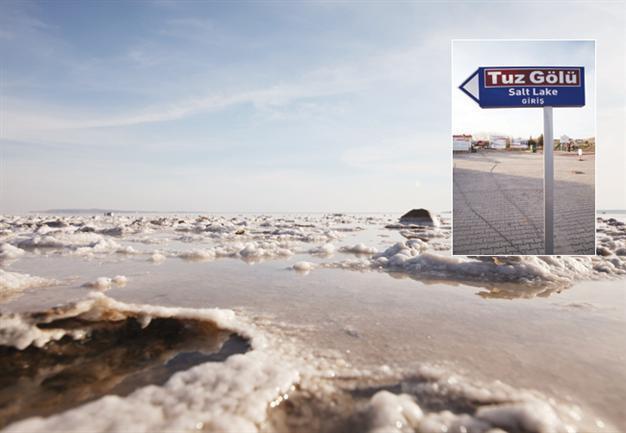Visiting the salt of the earth in Anatolia
WILCO VAN HERPEN

Visitors to Tuzgölü also visit the
souvenir shop where they can buy shampoos, mud masks, hand creams and etc with the essence of the lake. Wilco Van Herpen Photo
There is nothing as basic as salt. At least that is what I thought, until I went to Tuzgölü (a
salt lake near Şereflikoçhisar, about 150 kilometers from Ankara) to make a cooking program.
It was a Sunday afternoon, and the roads were very busy; everybody escaping the hectic life of the city and trying to get rid of the stress they had build up during their hectic life at the office. I got out the car and was surprised by the number of visitors. Two men were wandering around and an old woman, probably a grandmother, was threatening a young girl: “If you go any further in the lake that foreigner will get you and take you to the police,” she shouted. The child ignored her and looked at “the foreigner,” who had no idea of what had just been said. A veiled girl was posing and after taking the photos her girlfriend checked if the picture was nice.
Big pieces of salt
Most of the people visiting the lake spend around 15 minutes in or at the side of the lake. After taking pictures they walk back to the shore, visit the souvenir shop, or eat something in the restaurant. In front of the shop there are big pieces of salt piled on top of each other and some of these blocks have a beautiful pink color.

Visitors to Tuzgölü also visit the
souvenir shop, where they can buy
shampoos, mud masks and hand creams
made with the essence of the lake.
Wilco Van Herpen Photo
Inside the shop there were a number of very interesting products made of salt from the lake. I saw, for example, shampoos with an essence of the Tuzgölü, mud masks, and special hand cream, which the salesman assured me would make my hands as soft as a baby’s. With bags full of creams and souvenirs, the visitors leave as fast as they arrived; they had a nice day and some creams to show to their friends.
Every time I go to a place, people tell me that it is not the best time of the year to go. “You should have come in June, because then you can see the salt of the lake,” a guy told me, and unfortunately he was right.
If you want to see the crystallized salt you definitely should go in May or June but I wanted to see the lake filled with water. For that reason I decided to go there in March, just after the snow had disappeared and the sun had slowly started to gain back its incredible power. I like summer, but to go to Tuzgölü in June is a challenge.
Temperatures can rise above 30 degrees Celsius and walking on the snow white salt can feel as if you are walking around in the dessert. The sun, reflected by the salt, makes your skin turn red like a lobster in just half an hour. But now the weather is nice: 15 degrees and, more important, I can directly get in the water.
Going into the water
I wanted to see how salty the lake really was, so conducted a simple test. Someone told me that in a liter of water there can be as much as 350 grams of salt, but I wanted to see the actual level of salt. So I went into the water with a small pan in my hand and took half a liter of water. Even before I got out of the water my feet were snow white, covered with a thin layer of salt. But I was still curious how it would look if I boiled this water, so I sat there with my picnic burner and slowly the water started boiling. After ten minutes all the water had evaporated and a thick, beautiful layer of salt covered my pan. In it there was about 170 grams of salt, enough for me to use for at least 2 months. Nowadays we use too much salt and doctors say we just need two or three grams a day. After eating just one bag of chips or one ready-made pizza you have already exceeded this amount.
Recently, people started to become worried about the situation of the Tuzgölü,
Turkey’s second biggest lake after the Lake Van.
Tuzgölü is getting smaller every year, and if this continues, some professors have calculated that the lake will be gone within 10 years. Wrong irrigation methods and climate change have already had a big impact on the size of the lake. Something should be done quickly. So, looking at the lake as I did last Sunday is not just looking at a beautiful piece of nature and history, it is looking at a lake that is struggling to survive.
travel, anatolia, backpack,

